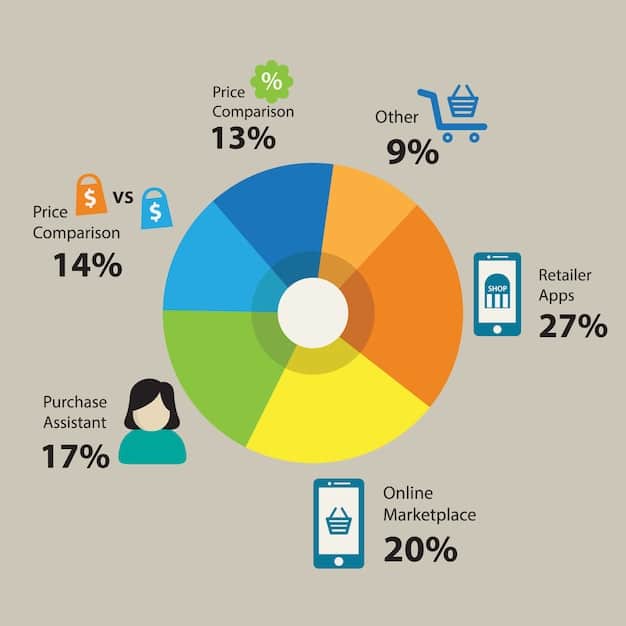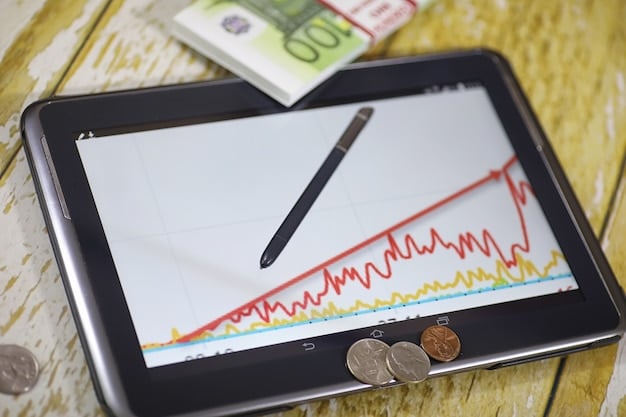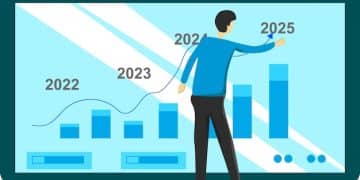Mastering Variable Expenses: A Practical Budgeting Guide

How to Budget for Variable Expenses: A Practical Guide involves identifying, tracking, and planning for costs that fluctuate monthly, such as groceries, utilities, and entertainment, ensuring financial stability and informed spending decisions.
Do you find it challenging to manage your budget when expenses like groceries, gas, and entertainment costs keep changing? Learning how to budget for variable expenses: a practical guide is essential to get control of your finances and achieve your financial goals. This guide provides the actionable tactics you need to navigate the unpredictable nature of variable expenses with confidence.
Understanding Variable Expenses
Variable expenses can often feel like a financial rollercoaster, but understanding them is the first step to mastering your budget. Unlike fixed expenses that remain constant each month, variable expenses fluctuate, making them seem unpredictable. However, with the right strategies, you can anticipate and manage these expenses effectively.
Defining Variable Expenses
Variable expenses are costs that change from month to month. These can include groceries, utilities, entertainment, transportation, and clothing. Since these expenses are not consistent, they require a different budgeting approach than fixed expenses like rent or loan payments.
Examples of Common Variable Expenses
Identifying your variable expenses is crucial for effective budgeting. Some common examples include:
- Groceries: The amount you spend on food can vary based on your meal planning and shopping habits.
- Utilities: Expenses like electricity, water, and gas can fluctuate depending on usage and seasonal changes.
- Transportation: Costs related to commuting, gas, and car maintenance can change based on how much you drive.
- Entertainment: Spending on movies, dining out, and hobbies can vary widely each month.

By understanding what constitutes a variable expense, you can begin to track and manage them more effectively, bringing greater financial stability to your budget.
Tracking Your Variable Expenses
Tracking your variable expenses is essential for gaining insight into your spending habits and identifying areas where you can save money. Without accurate tracking, it’s challenging to create a realistic budget and make informed financial decisions. Several methods can help you keep tabs on your expenses.
Methods for Tracking Expenses
There are several effective ways to track your variable expenses:
- Budgeting Apps: Mobile apps like Mint, YNAB (You Need A Budget), and Personal Capital can automatically track your expenses by linking to your bank accounts and credit cards.
- Spreadsheets: Creating a simple spreadsheet to record your expenses can provide a clear overview of your spending.
- Manual Tracking: Keeping a notebook or using a note-taking app to jot down your expenses can be a simple method for those who prefer a hands-on approach
Tips for Accurate Tracking
Accurate tracking is crucial for effective budgeting. Consider these tips:
- Record Every Expense: Make sure to note down every purchase, no matter how small. Those small expenses can add up over time.
- Categorize Expenses: Categorizing your expenses (e.g., groceries, entertainment) will help you see where your money is going.
- Review Regularly: Set aside time each week or month to review your expenses and identify any trends or areas for improvement.
Regularly tracking your expenses can help you identify spending patterns. Which helps you adjust your budget to align with your financial goals.
Creating a Realistic Budget
Creating a realistic budget is essential for managing your finances effectively. A well-designed budget helps you allocate your income wisely and achieve your financial goals. The key is to anticipate your variable expenses based on historical data and adjust as needed.
Estimating Variable Expenses
Start by reviewing your past spending data to estimate future expenses. Look at your bank statements, credit card bills, and expense tracking records from the previous months.
Adjusting Your Budget Based on Actual Spending
Once you have your estimated budget, it’s essential to compare it to your actual spending. This will help you identify discrepancies and adjust your budget accordingly. For example:
- If you consistently overspend on dining out, consider reducing your dining out budget and allocating those funds to other areas.
- If your utility bills are higher than expected, look for ways to conserve energy and lower your usage.
- If you find yourself spending more on transportation, consider carpooling to save money on gas

Creating a realistic budget involves continuous monitoring and adjustments. Regular reviews will help you stay on track and adapt to changing circumstances.
Strategies for Managing Variable Expenses
Managing variable expenses requires more than just tracking and budgeting; it involves implementing strategies to control your spending. Several techniques can help you reduce your variable expenses while still enjoying a comfortable lifestyle. Prioritizing and making informed decisions are key.
Prioritizing Essential vs. Non-Essential Expenses
Differentiating between essential and non-essential expenses can significantly impact your budget. Essential expenses are those necessary for your basic needs, such as groceries, utilities, and transportation. Non-essential expenses are discretionary and include entertainment, dining out, and hobbies. Consider these questions to guide your assessment:
- Can I reduce my spending on non-essential items without significantly impacting my quality of life?
- Are there cheaper alternatives for my essential expenses?
Techniques for Reducing Spending
There are numerous techniques to reduce your variable expenses:
- Meal Planning: Planning your meals in advance can help you reduce spending on groceries and avoid impulse purchases.
- Energy Conservation: Simple steps like turning off lights, using energy-efficient appliances, and adjusting your thermostat can lower your utility bills.
- Transportation Alternatives: Consider walking, biking, or using public transportation instead of driving to save money on gas and car maintenance.
By prioritizing essential expenses and implementing strategies to reduce spending, you can take control of your variable expenses and improve your overall financial health.
Using Budgeting Methods for Variable Costs
Various budgeting methods can help manage variable costs effectively. Each method offers a unique approach, and selecting the right one depends on your preferences and financial habits. Explore a few popular methods tailored to variable expense budgeting. These methods provide different ways to allocate and manage your funds, creating a structured approach to budgeting.
Envelope System
The envelope system is a cash-based budgeting method where you allocate a specific amount of cash to different expense categories each month. Once the cash in an envelope is gone, you cannot spend any more in that category. This method offers several advantages:
- Visual Tracking: Seeing the physical cash helps you stay aware of your spending.
- Reduced Overspending: Since you are limited to the cash in the envelope, it’s harder to overspend.
Zero-Based Budgeting
Zero-based budgeting involves allocating every dollar of your income to a specific purpose. Your income minus your expenses should equal zero. This method encourages mindful spending.
For example, if your monthly income is $3,000, you would allocate that amount to different expense categories, such as rent, groceries, utilities, and savings, until every dollar is accounted for.
50/30/20 Rule
The 50/30/20 rule allocates 50% of your income to needs, 30% to wants, and 20% to savings and debt repayment. Needs are essential expenses, wants are discretionary expenses, and savings and debt repayment contribute to your financial future.
By understanding and implementing these budgeting methods, creating a budget will help you gain better control over your variable expenses and achieve your financial objectives.
Adapting to Unexpected Expenses
Life is full of surprises, and unexpected expenses are inevitable. Having a plan for these situations can prevent financial stress and keep your budget on track. Preparing for these can provide peace of mind, ensuring you’re ready to tackle any financial curveballs that come your way.
Creating an Emergency Fund
An emergency fund is a savings account specifically for unexpected expenses. Aim to save three to six months’ worth of living expenses in your emergency fund. Consider these scenarios to understand the importance of an emergency fund:
- Job Loss: An emergency fund can cover your living expenses while you look for a new job.
- Medical Bills: Unexpected medical expenses can be a significant financial burden.
Adjusting Your Budget in Response to Changes
When unexpected expenses arise, you may need to adjust your budget temporarily. Take a look at where you can scale back, so you can adjust your budget accordingly to prioritize the expenses that need to be covered first.
| Key Point | Brief Description |
|---|---|
| 📊 Tracking Expenses | Use apps or spreadsheets to monitor your variable expenses closely and consistently. |
| 💰 Budgeting Methods | Explore envelope, zero-based, and 50/30/20 budgeting to manage variable costs effectively. |
| 🛡️ Emergency Fund | Build an emergency fund with 3-6 months of living expenses to handle unexpected financial setbacks. |
| 📉 Reducing Spending | Prioritize essential expenses and cut back on non-essential spending to control variable costs. |
Frequently Asked Questions (FAQ)
Variable expenses include costs that change from month to month, such as groceries, transportation (gas, public transit), utilities (electricity, water), entertainment, and dining out.
You should review your variable expenses at least once a month. This will help you identify patterns and make necessary adjustments to your budget.
The envelope system involves allocating cash to different expense categories each month. Once the cash in an envelope is spent, you can’t spend any more in that category.
You can reduce your utility bills by turning off lights when not in use, using energy-efficient appliances, adjusting your thermostat, and sealing drafts around windows and doors.
The 50/30/20 rule allocates 50% of your income to needs, 30% to wants, and 20% to savings and debt repayment, offering a simple guideline for managing your finances.
Conclusion
Mastering how to budget for variable expenses: a practical guide is essential for financial stability. By tracking your expenses, creating a realistic budget, implementing effective strategies, and adapting to unexpected costs, you can take control of your finances and achieve your financial goals.





